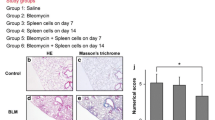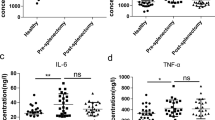Abstract
Background
Sustained liver injury causes liver fibrosis and eventually cirrhosis. Understanding the pathophysiological mechanisms of liver fibrosis and interventions in the fibrotic process is crucial for improving the prognosis of patients with chronic liver diseases. Although studies have shown that splenectomy suppresses liver fibrosis, the mechanism by which this occurs is poorly understood. The present study focuses on the immunological functions of the spleen to investigate its role in liver fibrosis.
Methods
BALB/c and severe combined immunodeficiency (SCID) mice underwent splenectomies or sham operations prior to induction of liver fibrosis with carbon tetrachloride or thioacetamide.
Results
Sirius red staining and hydroxyproline assays showed that splenectomy suppressed liver fibrogenesis in BALB/c mice. Reverse transcription PCR analysis of T helper type 1 (Th1) and T helper type 2 (Th2) cytokines demonstrated that splenectomy shifted the Th1/Th2 balance in the liver towards Th1 dominance. In SCID mice, the inhibitory effect on liver fibrosis was abrogated. The number of CD4+ T helper lymphocytes in the spleen decreased after liver injury. Green fluorescent protein positive (GFP+) splenocytes were transplanted into the spleens of syngeneic wild-type mice to trace their destination after fibrosis induction. GFP+CD4+ lymphocytes appeared in the liver after induction of fibrosis, and flow cytometry revealed the vast majority of them were Th2 lymphocytes. Transfer of splenocytes via the portal vein into syngeneic splenectomized mice cancelled the suppressive effect of splenectomy on liver fibrosis.
Conclusions
The present study demonstrated that Th2-dominant splenic lymphocytes migrate into the liver and promote liver fibrosis by shifting the cytokine balance towards Th2 dominance. Splenectomy suppresses the progression of fibrosis at least partly by restoring the Th1/Th2 balance.







Similar content being viewed by others
Abbreviations
- BDL:
-
Bile duct ligation
- GFP:
-
Green fluorescent protein
- IL:
-
Interleukin
- PBS:
-
Phosphate-buffered saline
- qRT-PCR:
-
Quantitative reverse transcription PCR
- SCID:
-
Severe combined immunodeficiency
- α-SMA:
-
α-Smooth muscle actin
- TAA:
-
Thioacetamide
- Th1:
-
T helper type 1
- Th2:
-
T helper type 2
References
Friedman SL. Mechanisms of hepatic fibrogenesis. Gastroenterology. 2008;134:1655–69.
Murata K, Ito K, Yoneda K, et al. Splenectomy improves liver function in patients with liver cirrhosis. Hepatogastroenterology. 2008;55:1407–11.
Imura S, Shimada M, Utsunomiya T, et al. Impact of splenectomy in patients with liver cirrhosis: results from 18 patients in a single center experience. Hepatol Res. 2010;40:894–900.
Sugawara Y, Yamamoto J, Shimada K, et al. Splenectomy in patients with hepatocellular carcinoma and hypersplenism. J Am Coll Surg. 2000;190:446–50.
Watanabe M, Murata S, Hashimoto I, et al. Platelets contribute to the reduction of liver fibrosis in mice. J Gastroenterol Hepatol. 2009;24:78–89.
Kodama T, Takehara T, Hikita H, et al. Thrombocytopenia exacerbates cholestasis-induced liver fibrosis in mice. Gastroenterology. 2010;138:2487–98.
Akahoshi T, Hashizume M, Tanoue K, et al. Role of the spleen in liver fibrosis in rats may be mediated by transforming growth factor β-1. J Gastroenterol Hepatol. 2002;17:59–65.
Shi Z, Wakil AE, Rockey DC. Strain-specific differences in mouse hepatic wound healing are mediated by divergent T helper cytokine responses. Proc Natl Acad Sci U S A. 1997;30(94):10663–8.
Patsenker E, Schneider V, Ledermann M, et al. Potent antifibrotic activity of mTOR inhibitors sirolimus and everolimus but not of cyclosporine A and tacrolimus in experimental liver fibrosis. J Hepatol. 2011;55:388–98.
van der Laan LJ, Hudson M, McPherson S, et al. Results of a two-center study comparing hepatic fibrosis progression in HCV-positive liver transplant patients receiving cyclosporine or tacrolimus. Transplant Proc. 2010;42:4573–7.
Taura K, Miura K, Iwaisako K, et al. Hepatocytes do not undergo epithelial-mesenchymal transition in liver fibrosis in mice. Hepatology. 2010;51:1027–36.
Popov Y, Sverdlov DY, Sharma AK, et al. Tissue transglutaminase does not affect fibrotic matrix stability or regression of liver fibrosis in mice. Gastroenterology. 2011;140:1642–52.
Taura K, De Minicis S, Seki E, et al. Hepatic stellate cells secrete angiopoietin 1 that induces angiogenesis in liver fibrosis. Gastroenterology. 2008;135:1729–38.
Arias-Diaz J, Ildefonso JA, Muñoz JJ, et al. Both tacrolimus and sirolimus decrease Th1/Th2 ratio, and increase regulatory T lymphocytes in the liver after ischemia/reperfusion. Lab Investig. 2009;89:433–5.
Novobrantseva TI, Majeau GR, Amatucci A, et al. Attenuated liver fibrosis in the absence of B cells. J Clin Investig. 2005;115:3072–82.
Farah IO, Mola PW, Kariuki TM, et al. Repeated exposure induces periportal fibrosis in Schistosoma mansoni-infected baboons: role of TGF-β and IL-4. J Immunol. 2000;164:5337–43.
Subra JF, Cautain B, Xystrakis E, et al. The balance between CD45RChigh and CD45RClow CD4 T cells in rats is intrinsic to bone marrow-derived cells and is genetically controlled. J Immunol. 2001;166:2944–52.
Nishimura H, Hattori S, Abe M, et al. Differential expression of three CD45 alternative structures on murine T cells: exon 6-dependent epitope as a marker for functional heterogeneity of CD4+ T cells. Int Immunol. 1992;4:923–30.
Okabe M, Ikawa M, Kominami K, et al. ‘Green mice’ as a source of ubiquitous green cells. FEBS Lett. 1997;407:313–9.
Czaja MJ, Weiner FR, Takahashi S, et al. γ-Interferon treatment inhibits collagen deposition in murine schistosomiasis. Hepatology. 1989;10:795–800.
Baroni GS, D’Ambrosio L, Curto P, et al. Interferon gamma decreases hepatic stellate cell activation and extracellular matrix deposition in rat liver fibrosis. Hepatology. 1996;23:1189–99.
Wynn TA. Fibrotic disease and the TH1/TH2 paradigm. Nat Rev Immunol. 2004;4:583–94.
Cheever AW, Williams ME, Wynn TA, et al. Anti-IL-4 treatment of Schistosoma mansoni-infected mice inhibits development of T cells and non-B, non-T cells expressing Th2 cytokines while decreasing egg-induced hepatic fibrosis. J Immunol. 1994;153:753–9.
Bosma GC, Custer RP, Bosma MJ. A severe combined immunodeficiency mutation in the mouse. Nature. 1983;301:527–30.
Roh YS, Park S, Lim CW, et al. Depletion of Foxp3+ regulatory T cells promotes profibrogenic milieu of cholestasis-induced liver injury. Dig Dis Sci. 2014. doi:10.1007/s10620-014-3438-2.
Swirski FK, Nahrendorf M, Etzrodt M, et al. Identification of splenic reservoir monocytes and their deployment to inflammatory sites. Science. 2009;325:612–6.
Vitetta ES, Brooks K, Chen YW, et al. T-cell-derived lymphokines that induce IgM and IgG secretion in activated murine B cells. Immunol Rev. 1984;78:137–57.
Coffman RL, Seymour BW, Lebman DA, et al. The role of helper T cell products in mouse B cell differentiation and isotype regulation. Immunol Rev. 1988;102:5–28.
Vierucci A, De Martino M, Novembre E, et al. Effect of the serum of patients with cholestasis on lymphocyte E rosette formation. Ann Sclavo. 1977;19:1119–29.
Li H, Xiong ST, Zhang SX, et al. Interleukin 2 production and its relationship with T lymphocyte subsets in patients with obstructive jaundice. J Tongji Med Univ. 1992;12:164–8.
Katz SC, Ryan K, Ahmed N, et al. Obstructive jaundice expands intrahepatic regulatory T cells, which impair liver T lymphocyte function but modulate liver cholestasis and fibrosis. J Immunol. 2011;187:1150–6.
Chaignaud BE, White JG, Nie CH, et al. Splenocytes from bile duct ligated rats do not elicit a normal immune response in the intact host. Am Surg. 1994;60:7–11.
Acknowledgment
This work was supported by a grant from the Japan Society for the Promotion of Science: Grant-in-Aid for Scientific Research (B), no. 23390322.
Conflict of interest
The authors declare that they have no conflict of interest.
Author information
Authors and Affiliations
Corresponding author
Electronic supplementary material
Below is the link to the electronic supplementary material.
Rights and permissions
About this article
Cite this article
Tanabe, K., Taura, K., Koyama, Y. et al. Migration of splenic lymphocytes promotes liver fibrosis through modification of T helper cytokine balance in mice. J Gastroenterol 50, 1054–1068 (2015). https://doi.org/10.1007/s00535-015-1054-3
Received:
Accepted:
Published:
Issue Date:
DOI: https://doi.org/10.1007/s00535-015-1054-3




